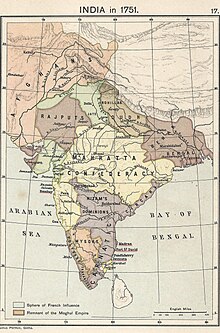
The decline of the Mughal Empire was a period in Indian history roughly between the early 18th century and mid 19th Century where the Mughal Empire, which once dominated the subcontinent, experienced a large scale decline. There are various factors responsible for this decline such as internal conflicts, Rajput, Sikh and Maratha rebellions, Afghan and Persian invasions and expansion of East India Company influence and power.
The period is said to have begun with the death of Bahadur Shah I in 1712 and ended with the deposition of Bahadur Shah II in 1857. The period was marked by rebellions by Marathas, Jats, Sikhs and Rajputs, foreign invasions by Afghans and Persians. A number of provinces became hereditary vassal monarchies who ruled nominally in the name of the emperor. All powers, including the Marathas and British, nominally ruled in the name of the emperor, and the politics of the era was marked by these powers trying to gain a larger influence over the emperor than the other.